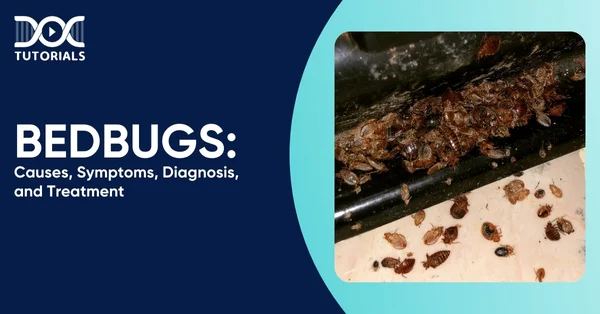Bedbugs | Causes, Symptoms, Diagnosis, and Treatment

Bedbugs (Climex spieces) are tiny, wingless, reddish-brown insects that feed on human blood, typically during the night. They nest in mattress creases, bed frames, and furniture crevices, and come out at night to bite people when they are sleeping. Their bites typically cause red, itchy welts in a zigzag pattern and can result in allergic reactions and bedbug infections.
A bedbug bite is not a serious medical problem, but it can have a significant effect on health. So, it’s important for NEET PG candidates like you to know the implications of these bites to excel in the exam. Read ahead for a more in-depth insight into bedbug bites.
What Causes Bedbugs Infestations?
Bedbug infestations happen due to their capacity to land on used furniture, luggage, clothing, or bedding from infested destinations. They can quickly spread in shared living spaces like apartments, hotels, or dormitories, via air, water, or electricity moving through walls, pipes, or outlets.
Increased global travel, insecticide resistance, and shifts in pest control methods have heightened their rise. Additionally, their flat bodies allow them to take shelter in small crevices, making them difficult to detect early on. Neglected or unoccupied homes can unknowingly have bedbugs for months.
What are the Symptoms of Bedbug Bites?
Bedbug bites symptoms may not show up for days following the bite and can also differ among individuals. Some people have no symptoms at all, whereas others experience visible and, in some cases, severe reactions. Some common symptoms are:
- Red, raised, and itchy welts, appearing in rows or clusters (commonly referred to as the “breakfast, lunch, and dinner” pattern).
- Blisters, hives, or intense itching in people with allergic reactions.
- Spots with an inflamed and darker red centre.
- Burning or mild pain at the bite area.
- Bites on exposed skin regions like the face, neck, arms, and hands.
- Secondary skin infection risk from scratching excessively.
- Possible rare but severe symptoms include nausea, fever, shortness of breath, swollen tongue, abnormal heart rate, or anaphylaxis that requires immediate medical care.
How to Diagnose Bedbug Bites?
To diagnose if someone is bitten by a bedbug, look for physical indications and examine the house area for signs of an infestation. The bites seem like red, itchy pimples in patches or lines, and they frequently show up on parts of skin that are exposed, such the face, arms, or feetThey are easily confused with other insect bites or skin conditions.
A more effective diagnosis entails the examination of mattresses, seams of furniture, and crevices of walls for live bugs, dark faecal spots, shed skins, or rusty-red stains. In certain situations, a doctor is referred to in order to eliminate other possibilities, such as scabies, eczema, or allergic reactions.
What is the Treatment for Bedbug Bites?
Bedbug bites do not usually constitute a significant health hazard and tend to heal spontaneously within one to two weeks. However, there are certain treatment methods that can be adopted in case the situation deteriorates. These are:
- Symptomatic Treatment of Bites
Start by gently washing the bite area with soap and water in order to clean the skin and avoid secondary infection. For relief of itch and redness, use an anti-itch lotion or cream containing hydrocortisone.
If the irritation persists, reapply once or twice a day until symptoms subside. In severe instances where the itching becomes intolerable or causes swelling, a medical doctor may prescribe a more potent corticosteroid-like cream or recommend oral or prescription antihistamines, including diphenhydramine (Benadryl), to calm the allergic reaction.
- Treating the Infestation at Home
Removing bed bugs from your home is a crucial aspect of treatment. Unless the bedbug infestation is fully cleared, bites will continue. Vacuuming thoroughly the cracks of furniture, baseboards, and mattresses is among the initial steps to eliminate as many bugs and eggs as possible.
- Heat-Based Strategies
Clothing, bed linens, and other washable items under bedbug infestation should be washed in hot water (a minimum of 120°F or 48.9°C) and then dried on the hottest setting for a minimum of 20 minutes. Heat is a very effective non-chemical means to kill bed bugs and their eggs.
What are the Tips to Avoid Bedbug Bites?
If you are worried about bedbugs, follow these effective tips to keep the risk of bedbugs at bay:
- If you travel frequently, consider acquiring a device that heats your suitcase to a temperature that will eliminate any bedbugs.
- Examine second-hand furniture, linens, or clothing for signs of bedbugs before introducing them into your home.
- Utilise luggage racks during your travels to keep your clothes elevated off the floor and away from hotel furniture.
- Store your clothing in vacuum-sealed bags while travelling.
- If you use a communal laundry facility, carry your clothes in plastic bags and refrain from folding them until you are back home.
- If you have developed bedbug bites, avoid scratching them, as it might worsen the situation.
FAQs About Bedbugs Bites
- How long does it take for bedbug bites to show up?
Bedbug bite marks can take anywhere from a few hours to as long as 14 days to become visible. Some people may not exhibit any marks at all or may only experience mild, localised reactions.
- Which parts of the body are most commonly bitten by bedbugs?
Bed bugs tend to bite exposed skin areas with thinner skin, especially at night. They are found commonly on the face, neck, arms, hands, and legs since these areas offer convenient access to blood vessels.
- What problems can bedbug bites cause?
Even though bed bugs do not transmit diseases, their bites can cause intense itching, disrupted sleep, and, in a few cases, allergic reactions. Excessive scratching can also cause secondary skin infections.
- What draws bedbugs in?
Bedbugs are largely drawn to carbon dioxide, body heat, and human odours, particularly when people are not moving, like sleeping. They also seek out dark, obscure places such as cracks, crevices, and disarray where they can hide and reproduce.
- Are there any adverse effects of bedbugs?
There are some people who do not respond to bedbug bites, while others experience an allergic reaction in the form of severe blisters, itching, or hives.
Conclusion
Bedbugs bites can cause itchy welts and allergic reactions, and may even lead to skin infections. At DocTutorials, we provide expertly designed NEET PG materials, high-yield information, and learning resources. To excel in many such medical topics, we help prepare students to crack the exam with clarity and confidence.
Join DocTutorials to explore our NEET PG course today!
Latest Blogs
-

NEET SS Exam 2024: Analysis, Key Dates, Counselling
The NEET SS 2024 exam kicked off on March 29, 2025. Over two days and two slots, candidates across 13…
-

NEET PG Registration 2025: An Essential Guide For Exam Prep
The NEET PG registration, which is conducted online, is a crucial step in the exam process. Filling out the NEET…
-

NEET PG Syllabus 2026: A Must-Have Complete Guide for Exam Success
The NEET PG Syllabus acts as one of the foundation stones for aspiring postgraduate medical students like you who are…




